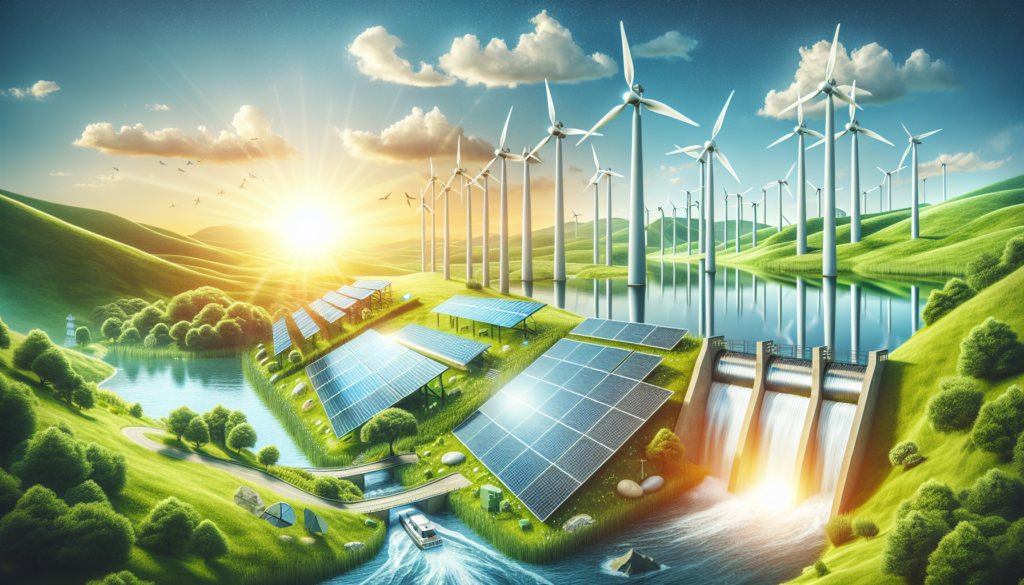Renewable energy’s share of US electricity generation remained stable at 22% in 2023, marking a pivotal moment in the global adoption trends in renewable energy. This shift away from fossil fuels towards renewable energy sources underscores the urgency and growing commitment to sustainable power generation across the globe.
The article will delve into the surge of global investment in renewable energy, highlight the technological advancements propelling its adoption, and explore the varied regional patterns and challenges. Furthermore, it aims to project the future outlook for renewable energy adoption, focusing on the critical role of investment trends and government incentives in shaping a greener power grid.
Global investment in renewable energy
Record-Breaking investments in renewable energy
In 2023, global investment in the energy transition surged to an unprecedented $1.8 trillion, marking a 17% increase from the previous year. This substantial financial commitment underscores the growing global emphasis on sustainable energy solutions. Notably, investment in renewable energy itself reached $623 billion, reflecting an 8% increase, highlighting a robust commitment to transitioning away from fossil fuels.
Leading contributors and investment areas
China continued to dominate the landscape as the largest market for energy transition investment, contributing a staggering 38% of the global total. In contrast, the United States and the European Union also demonstrated significant growth, with investments totaling $303 billion and $360 billion, respectively. These investments are pivotal in driving the shift towards a more sustainable and resilient global power grid.
The rise of solar energy and electrified transport
Solar energy investments reached a new high of $380 billion in 2023, surpassing investments in upstream oil sectors. This shift not only reflects the cost-effectiveness of solar energy but also its increasing viability as a primary energy source. Additionally, the investment in electrified transport soared to $634 billion, accounting for more than a third of the total investment in the energy transition, which indicates a rapid move towards electric vehicles and other forms of clean transportation.
Financing climate goals and the role of the private sector
The private sector has emerged as a critical player, providing around 75% of total renewable energy investments from 2013 to 2020. Institutional investors, such as pension funds and sovereign wealth funds, are increasingly recognized for their potential to scale up investments in renewable energy. Furthermore, green bonds have become pivotal in bridging the gap between capital providers and renewable energy projects, facilitating increased investments in this sector.
Challenges and future needs
Despite these positive trends, the investment in renewable energy needs to triple to meet essential climate and development goals. Current investments remain concentrated in a few countries and technologies, indicating a need for more diversified investment strategies. Moreover, sound policy frameworks are essential to attract further private sector investment and to ensure that these funds are channeled effectively to foster global energy transition.
By addressing these challenges and leveraging the momentum of current investment trends, the global community can ensure a sustainable and equitable energy future, aligning with the goals of reducing carbon emissions and enhancing energy security worldwide.
Discover: Why Compliance and Legal AI is Revolutionizing the Industry
Technological advancements driving adoption
Heat pumps and electric vehicles: catalysts for change
The renewable energy sector has witnessed remarkable growth in heat pump sales and electric vehicle (EV) adoption. Since 2021, global heat pump sales have experienced double-digit annual growth, and 2023 anticipates a further increase in EV sales by a third. These advancements not only reflect a shift in consumer preferences but also underscore the increasing reliability of these technologies in reducing carbon footprints.
Solar and wind energy: scaling new heights
The U.S. Energy Information Administration projects a significant expansion in solar and wind capacities. Utility-scale solar installations are expected to more than double compared to 2022, reaching a record-breaking 24 GW. Similarly, wind capacity is set to rise by 8 GW. These figures highlight the escalating commitment to scaling up renewable energy sources to meet growing energy demands.
Pioneering projects and innovations
SolarisFloat, a Portuguese renewable energy company, is at the forefront with its Protevs project, which involves developing sun-tracking solar farms across Europe. The pilot project at Oostvoornse lake in the Netherlands features 139 modules of floating PV solar panels. This innovative sun-tracking technology allows the panels to rotate towards the highest solar concentration, enhancing energy production by 40% compared to standard floating panels.
Energy storage and smart grids: enhancing efficiency
Technological innovations in energy storage and smart grids are pivotal in addressing the intermittent nature of renewable energy sources. Advances in battery storage technologies, such as lithium glass batteries, and the development of smart grids facilitate more efficient energy management and integration into the power grid.
The role of legislation in technological adoption
Significant legislative measures such as the Inflation Reduction Act (IRA) and the Infrastructure Investment and Jobs Act (IIJA) have catalyzed a domestic clean energy manufacturing revival. These acts not only boost the demand for critical minerals essential for renewable energy technologies but also drive advancements in technology and infrastructure, essential for a sustainable energy future.
Emerging technologies in wind and solar energy
The development of bladeless turbine technology represents a leap forward in wind energy, offering a quieter and safer alternative to traditional turbines. In solar technology, researchers are exploring high-efficiency options like multi-junction and tandem cells, as well as perovskite-silicon hybrid cells, which promise to revolutionize solar energy efficiency and cost-effectiveness.
Integration and forecasting tools
AI and big data are playing crucial roles in enhancing grid analytics and management. These technologies enable quick, real-time decision-making for utilities, improving power consumption forecasting and predictive maintenance. This integration is essential for maintaining a stable and efficient power grid as the share of renewable energy sources grows.
These technological advancements are not just enhancing the efficiency and capacity of renewable energy sources but are also making them more accessible and reliable. As these technologies continue to evolve and scale, they play a critical role in the global transition to a more sustainable energy landscape.
Regional adoption patterns and challenges
Varied regional adoption dynamics
1. Emerging and developing economies
Emerging and developing economies face significant hurdles in clean energy investment, largely due to limited access to financing and insufficient infrastructure. These regions often lack the robust regulatory frameworks necessary to attract substantial investments, which are crucial for fostering a transition to renewable energy.
2. The European Union’s innovative projects
In contrast, the European Union is making strides with projects like the REGACE agrivoltaic initiative. This project, funded with €5.3 million, integrates solar PV panels with agricultural practices, enhancing efficiency and fostering symbiotic relationships between energy production and farming.
Challenges in renewable energy adoption
1. Intermittency issues
A major challenge across all regions is the intermittency of renewable energy sources like solar and wind power. Solar energy, while abundant, depends heavily on daylight and weather conditions, limiting its reliability. Similarly, wind energy requires consistent wind patterns and large areas for effective operation.
2. Geographical and technological limitations
Hydropower and geothermal energy, although reliable, are geographically dependent. Hydropower requires specific topographical features and can have significant environmental impacts, while geothermal energy needs advanced drilling technologies and is limited to areas with suitable geological conditions.
3. Biomass energy complications
Biomass energy faces challenges related to feedstock availability and emissions management. These issues, coupled with land use conflicts, make it a less favorable option in regions where agricultural land is scarce or highly valued for food production.
Infrastructure and economic factors
1. High initial costs and economic viability
The adoption of renewable energy is often hindered by high initial costs and the need for the levelized cost of electricity to be competitive with fossil fuels. This economic challenge is particularly pronounced in regions where financial resources are limited.
2. Grid integration and infrastructure needs
Effective grid integration is essential for the adoption of renewable energy. This includes the expansion of transmission networks and upgrades to existing grids, which can be cost-prohibitive and technically complex, especially in less developed regions.
3. Public perception and policy support
Public acceptance and consistent government policies play a critical role in the adoption of renewable energy. Resistance from communities or industries that rely on fossil fuels, along with policy inconsistency, can significantly impede progress.
Regional success stories
1. Denmark and wind energy
Denmark has successfully integrated wind power into its energy system, setting an example for effective renewable energy adoption.
2. Germany’s solar power initiatives
Germany continues to make significant advancements in solar power, demonstrating the potential for scalable renewable energy solutions.
3. Costa Rica’s renewable energy achievement
Costa Rica generates over 98% of its electricity from renewable sources, showcasing what comprehensive policy support and public acceptance can achieve in driving renewable energy adoption.
Future outlook for renewable energy adoption
Demand and supply projections for critical minerals
The renewable energy sector’s expansion is closely tied to the availability of essential minerals such as lithium, cobalt, and nickel, vital for energy storage solutions and various renewable technologies. By 2035, the demand for lithium and cobalt is projected to increase by 15%, while nickel demand could rise by 14%. Copper, essential across all energy transition technologies, is expected to see a 12% rise in demand. These trends underscore the need for robust mining and recycling policies to ensure a steady supply of these critical resources.
Policy and regulatory framework enhancements
Future strategies in renewable energy adoption emphasize the importance of refining policy and regulatory frameworks. Governments are urged to create more favorable conditions for renewable energy investments and innovations. This includes establishing clear guidelines for the integration of renewable systems into the national grids, supporting R&D through subsidies and grants, and fostering international cooperation to share best practices and technologies.
Public awareness and education initiatives
Increasing public awareness and education about the benefits of renewable energy is crucial for its broader acceptance and use. Programs aimed at informing the public about the environmental and economic benefits of renewable energy can drive community-level changes, influencing local policies and consumer behavior towards greener alternatives.
Advancements in renewable energy market design
To accommodate the growing share of renewable energy, market designs must evolve. This involves developing more flexible power grids that can handle the variability and intermittency of renewable sources like solar and wind. Enhancements in grid infrastructure, along with innovative market mechanisms, are necessary to ensure stability and efficiency in energy distribution.
Circular economy integration
Adopting a circular economy approach in the renewable energy sector involves the reuse and recycling of components such as solar panels and batteries. This not only reduces waste but also decreases the dependency on raw materials, which are often limited and environmentally challenging to extract.
Global renewable power capacity projections
Based on existing policies and market dynamics, it is projected that by 2028, the total capacity of renewable energy worldwide will escalate to 7,300 GW, predominantly driven by advancements in solar photovoltaics and wind power. These sources are projected to account for 95% of the expansion, highlighting their growing dominance in the energy sector. By the start of 2025, it is anticipated that renewable energy sources will overtake coal as the leading source of electricity worldwide, signifying a crucial step forward in the shift towards sustainable energy.
Challenges and strategic recommendations
Despite the positive trajectory, the global energy transition faces significant challenges, including the ongoing impacts of the COVID-19 pandemic and geopolitical tensions, such as those arising from the Ukraine crisis. To address these issues and keep global warming within 1.5°C, comprehensive strategies involving aggressive CO2 emission reductions and a swift move towards net-zero targets are essential. The integration of renewable energy into the global mix is expected to rise significantly, necessitating continued innovation and investment in clean energy technologies.
You’ll definitely be interested: Software asset management best practices

Investment trends and government incentives
The impact of legislative acts on renewable energy investments
The Inflation Reduction Act (IRA) and the Infrastructure Investment and Jobs Act (IIJA) have significantly influenced the renewable energy sector by introducing new or expanded programs, grants, and tax credits. These legislative measures have not only increased the demand for critical minerals essential for renewable energy technologies but have also catalyzed substantial investments in solar and storage solutions. Notably, utility-scale solar has captured the largest share of both announced and actual investments, reflecting a strategic focus on enhancing the solar infrastructure.
Major renewable energy projects influenced by investment trends
- Repsol’s Delta II Wind Project: Initiated in May 2021, this project spans six wind farms in Spain with a total capacity of 860 MW. Set to be operational in 2023, it represents a significant advancement in harnessing wind energy.
- OX2’s 1.4 GW Offshore Wind Farm: Located off the coast of Finland, this substantial project involves 100 turbines that will generate approximately 6 TWh of electricity annually, marking a major step in offshore wind energy development.
- Iberdrola’s 1.2 GW Solar Project: In partnership with Prosolia, Iberdrola is constructing what will be Europe’s largest solar plant and the fifth largest globally, demonstrating the scale of investment flowing into solar energy.
Government incentives boosting renewable energy adoption
The U.S. government offers a variety of financial incentives aimed at encouraging the production and utilization of renewable energy. These include:
- Renewable Electricity Production Tax Credit (PTC): A critical incentive for projects involving wind, geothermal, biomass, and hydroelectric power, which has significantly reduced the cost of wind power since 1980.
- Investment Tax Credit (ITC): Primarily benefits the solar industry by offering a credit worth 30% of the initial investment, encouraging further development in solar technologies.
- Modified Accelerated Cost-Recovery System (MACRS): Enables faster depreciation of renewable energy assets, improving the financial attractiveness of investing in renewable technologies.
- Feed-in Tariffs (FITs): Offers guaranteed higher rates for renewable electricity, providing a stable economic environment for renewable energy investments.
Strategic policy frameworks enhancing renewable energy markets
Renewable Portfolio Standards (RPS) and Renewable Energy Certificates (RECs) are pivotal in shaping the renewable energy market:
- Renewable Portfolio Standards (RPS): These standards mandate that a certain percentage of electricity sold by utilities must come from renewable sources by a specified date, driving the integration of renewable energy into the national power grid.
- Renewable Energy Certificates (RECs): These certificates allow consumers to contribute to renewable energy production indirectly, fostering a broader participation in the renewable energy movement.
The role of federal research and development
The U.S. Department of Energy (DOE) along with other federal agencies, invests heavily in the research and development of renewable energy technologies. This not only enhances the technological base of renewable energies but also ensures ongoing innovation and efficiency improvements, vital for sustaining the growth of renewable energy sectors.
Case studies: Success stories in renewable energy adoption
Mohammed bin Rashid Al Maktoum Solar Park, Dubai, UAE
The Mohammed bin Rashid Al Maktoum Solar Park in Dubai exemplifies a monumental stride in solar energy. As the world’s largest single-site solar park, it spans 30 square miles. Scheduled for completion in 2030, it is set to have a production capacity of 5000MW, which will contribute to saving over 6.5 million tons of carbon emissions annually. This project not only reflects the scale of investment in renewable energy but also emphasizes the UAE’s commitment to leading in sustainable energy solutions.
Hornsea Two Offshore Wind Farm, UK
The Hornsea Two project, situated in the North Sea off the coast of Yorkshire, stands as the world’s largest offshore wind farm. With a generation capacity of over 1300MW, it powers more than 1.4 million UK homes. This project showcases the UK’s efforts in scaling up renewable energy production and its potential to significantly reduce reliance on fossil fuels.
Gansu Wind Farm, China
China’s Gansu Wind Farm, the largest onshore wind farm globally, currently produces 8GW of renewable energy. Upon completion, this farm will feature 7000 wind turbines with a combined output of 20GW. This immense project highlights China’s ambitious renewable energy initiatives and its role in shaping global renewable energy adoption trends.
NEOM Green Hydrogen Project, Saudi Arabia
In Saudi Arabia, the NEOM Green Hydrogen Project is set to become the world’s largest green hydrogen production facility. A joint venture between ACWA Power, Air Products, and NEOM, it aims to produce 500 tons per day of carbon-free hydrogen by the end of 2026. This project represents a significant advancement in the use of renewable energy for sustainable hydrogen production.
Integrated Renewable Energy Project (IREP), India
The Pinnapuram IREP in India integrates 1GW of solar power, 600MW of wind power, and 10.8GWh of pumped storage hydroelectric power. This project underscores the critical role of energy storage in providing reliable, schedulable power to meet varying consumer demands. It serves as a model for other regions looking to integrate multiple renewable energy sources effectively.
FAQs
What is the current direction of renewable energy on a global scale?
The global trend in renewable energy is characterized by the fastest expansion in power generation capacity from renewables in the last thirty years. The International Energy Agency (IEA) forecasts that by 2025, renewable sources such as solar, wind, and hydro will overtake coal as the leading source of electricity worldwide.
How widely has renewable energy been adopted globally?
As of 2022, there has been a nearly 8% increase in the supply of renewable energy from sources like solar, wind, hydro, geothermal, and ocean technologies. This growth has resulted in these technologies accounting for 5.5% of the total global energy supply, a rise of almost 0.4 percentage points. Additionally, the contribution of modern bioenergy to the global energy supply grew by 0.2 percentage points, reaching 6.8%.
What are the barriers to the broader adoption of renewable energy resources?
The adoption of renewable energy has been limited due to spatial requirements. Renewable energy installations, such as wind farms and solar plants, demand significant land areas. Wind turbines need to be evenly distributed, and solar plants occupy more space than conventional power plants, while also being less efficient.
What are the anticipated trends for renewable energy in the year 2024?
Looking ahead to 2024, several key trends are expected to influence the renewable energy landscape. These include regulatory incentives leading to historic investments in renewables, a significant increase in solar and storage deployments, and the emergence of clean hydrogen. Although offshore wind is facing challenges, the primary hurdle to address will be the development of transmission infrastructure to support these expanding energy sources.
Do you need to handle your renewable energy contracts without relying on a legal team? We are experts in streamlining this process to be fast and straightforward, eliminating the need for lawyers. Please request a demo to see how we can make your operations more efficient.









